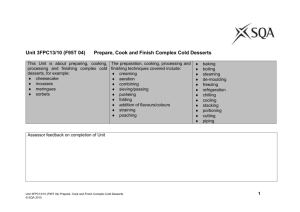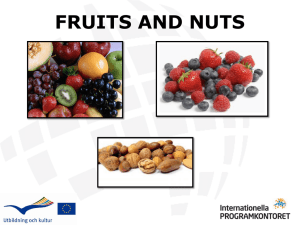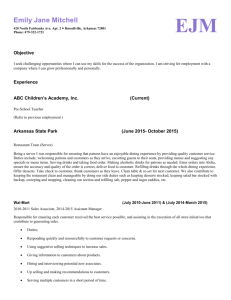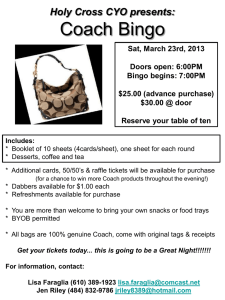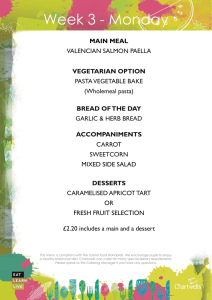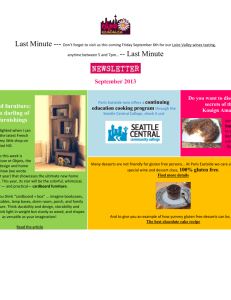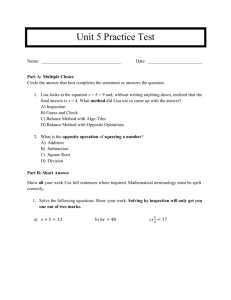Unit 249 Prepare, cook and finish basic cold and hot desserts
advertisement
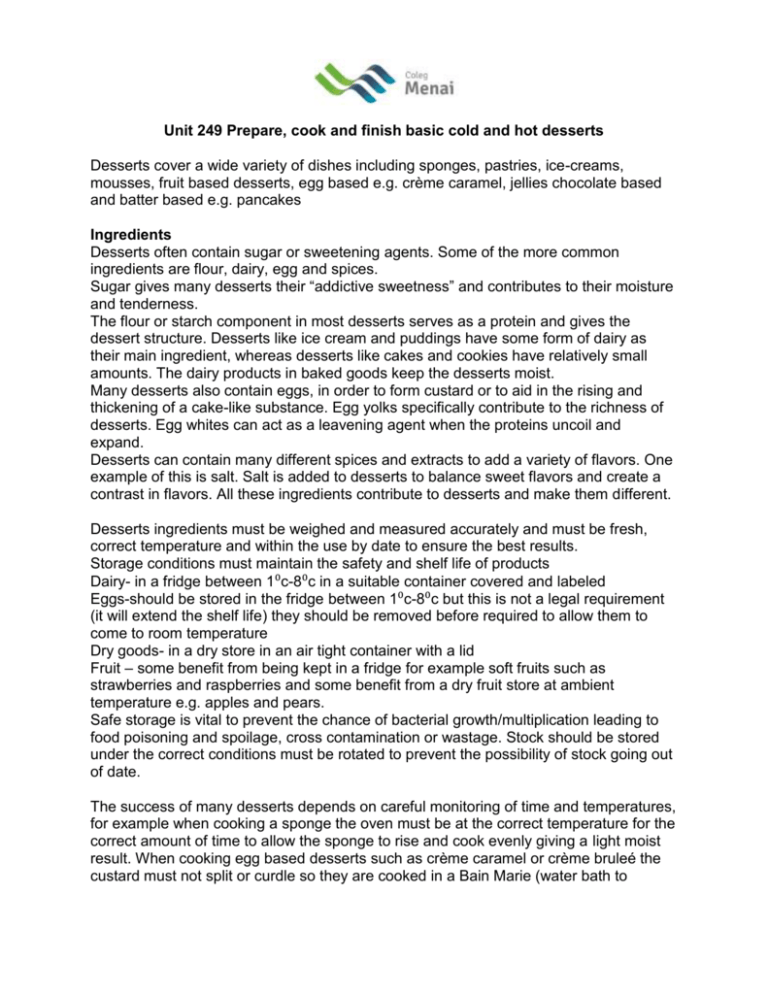
Unit 249 Prepare, cook and finish basic cold and hot desserts Desserts cover a wide variety of dishes including sponges, pastries, ice-creams, mousses, fruit based desserts, egg based e.g. crème caramel, jellies chocolate based and batter based e.g. pancakes Ingredients Desserts often contain sugar or sweetening agents. Some of the more common ingredients are flour, dairy, egg and spices. Sugar gives many desserts their “addictive sweetness” and contributes to their moisture and tenderness. The flour or starch component in most desserts serves as a protein and gives the dessert structure. Desserts like ice cream and puddings have some form of dairy as their main ingredient, whereas desserts like cakes and cookies have relatively small amounts. The dairy products in baked goods keep the desserts moist. Many desserts also contain eggs, in order to form custard or to aid in the rising and thickening of a cake-like substance. Egg yolks specifically contribute to the richness of desserts. Egg whites can act as a leavening agent when the proteins uncoil and expand. Desserts can contain many different spices and extracts to add a variety of flavors. One example of this is salt. Salt is added to desserts to balance sweet flavors and create a contrast in flavors. All these ingredients contribute to desserts and make them different. Desserts ingredients must be weighed and measured accurately and must be fresh, correct temperature and within the use by date to ensure the best results. Storage conditions must maintain the safety and shelf life of products Dairy- in a fridge between 1⁰c-8⁰c in a suitable container covered and labeled Eggs-should be stored in the fridge between 1⁰c-8⁰c but this is not a legal requirement (it will extend the shelf life) they should be removed before required to allow them to come to room temperature Dry goods- in a dry store in an air tight container with a lid Fruit – some benefit from being kept in a fridge for example soft fruits such as strawberries and raspberries and some benefit from a dry fruit store at ambient temperature e.g. apples and pears. Safe storage is vital to prevent the chance of bacterial growth/multiplication leading to food poisoning and spoilage, cross contamination or wastage. Stock should be stored under the correct conditions must be rotated to prevent the possibility of stock going out of date. The success of many desserts depends on careful monitoring of time and temperatures, for example when cooking a sponge the oven must be at the correct temperature for the correct amount of time to allow the sponge to rise and cook evenly giving a light moist result. When cooking egg based desserts such as crème caramel or crème bruleé the custard must not split or curdle so they are cooked in a Bain Marie (water bath to prevent boiling, pastry items must not be undercooked or they will be soggy or overcooked or they will be burnt and hard. Cold desserts such as jellies and mousses must be allowed to set at correct temperatures and chocolate must not be chilled. Quality points to look for in desserts Texture Taste Colour Smell Taste Temperature Date Eye appeal Various tools are required to prepare and cook desserts Moulds, spoons, bowls, boards, knives, piping bags, pans, trays, forks, whisks, mixers, blenders, marble slabs, cake tins, steamer, oven, range, deep fryer, frying pan, griddle, grill, tongs and specialist equipment such as sugar thermometers and chocolate boilers. Preparation methods Slicing- a thin flat piece cut from a large object Creaming –work to form a smooth paste, e.g. butter and sugar for Victoria sponge 1. Folding-Mix an ingredient gently with (another ingredient), esp. by lifting a mixture with a spoon so as to enclose it without stirring or beating. Moulding- gives shape to Mixing- Combine or put together to form one substance or mass. Aeration – incorporating air Addition of flavours/colours – to add purees essences and colourings, extracts and spices. Pureeing –to put through a sieve or blender to form a smooth paste Combining- to mix Portioning – to divide usually into equal amounts can be by weight, size or volume. Chilling- to cool in a refrigerator or a blast chillier Boiling/ poaching-Heat (a liquid) to the temperature at which it bubbles and turns to vapor Stewing-to cook in liquid on the stove Baking- cook in dry heat in an oven Combination cooking- methods that employ both dry and moist heat Steaming - is the cooking of prepared foods by steam (moist heat) under varying degrees of pressure Bain –Marie- to cook in a water bath Frying- to cook food in hot fat can be deep or shallow. Filling- an edible mixer put into a pie or mould Glazing- coating to give a shine Piping- to push food, sauce etc. through a nozzle to garnish. Garnish- To enhance in appearance by adding decorative touches

